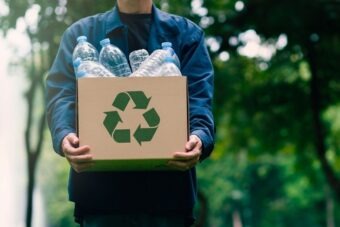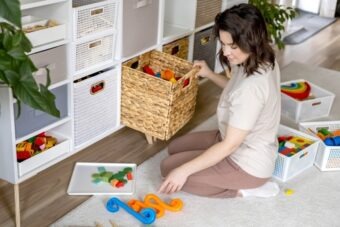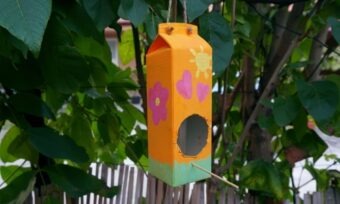How to Reuse and Upcycle Your Supplement Containers
Posted: November 1, 2024 | By: Shanon Peckham

Did you know that only 5% of all plastics are actually recycled here in the U.S.?1
November is National Recycling Month! Instead of tossing your old Youngevity canisters, jars, bottles, and cardboard boxes into the trash or throwing them in the garage to deal with later, you can give them new life and help the planet at the same time.
Today, we’re sharing a bunch of different ways you can transform, reuse, and properly recycle your old supplement packaging. No more storing bulky old canisters waiting for inspiration or debating whether something is recyclable!
Sustainable Storage
If you’re not quite ready to part with your supplement containers, we’ve got good news: you can reuse them in so many ways! Instead of being an organizational nightmare, your empty containers can actually increase your storage capacity and efficiency. You can use your canisters as storage for dry goods like laundry powder or crafting accessories. They’re airtight and made to store something edible, so they’re safe to use for perishable foods like rice, cereal, oatmeal, pet food, and coffee grinds (perfect for the emergency pantry). You can also double up the amount of supplement powder inside each canister for more storage space in your pantry.
If you’re feeling crafty, you can turn a large or medium canister (think Doc’s Birthday Cake Protein Shake) into a plastic bag dispenser for the kitchen or garage! All you need to do is cut a hole in the bottom front of your container and, voila, you have another way to rein in the chaos and clutter of your home. Pretty awesome, right? Small to medium canisters (like 3.0 Rise & Restore™) are great for DIY pencil or toothbrush holders, while tablet and capsule bottles (like Ultimate Daily™) make great storage for small items like paperclips, push pins, or safety pins. Just make sure you don’t put leftovers, harsh chemicals, or anything hot into your containers for storage;2,3 they may be well-sealed, but they don’t mix well with everything. If you want to use your container for something specific, we recommend researching it to make sure it’s safe!
Getting Started: First, soak or peel the labels off of your jars and canisters. For cardboard boxes, you can paint over the labels if you want! This leaves you free to add your own labels or designs.
Expand Your Garden
Your garden is another great spot to employ your empty containers. If you’re just starting a garden and have a tight budget, you can save money on pots by planting your herbs, succulents, and flowers in canisters. Large containers can even be converted/combined for growing certain crops like root vegetables or mushrooms. Potatoes grow well in bucket-sized containers; all you need to do is dump the container to harvest at the end of the season!4 If you’re feeling extra ambitious, you can also try growing mushrooms;5 the large protein powder canisters are perfect since they make a tight seal. When in doubt, large and medium canisters make excellent sand/dirt storage containers (sealed = keep out bugs!) or a DIY watering can with a small hole added.
Small containers are a bit trickier to reuse, but we’ve thought of uses for them too! From cartons and jugs to canisters and bottles, almost any container can be used to make your own DIY bird feeder. A box cutter, bird seed, paint (or paper, or stickers), and some craft wire are all you need!6 Small and medium canisters may also be big enough to be used for plant transplants and hosting small plants as well. Clear and transparent containers (think Synaptiv™ bottles) also make a great starter home for your air ferns, seedlings, and baby root systems. Did you know you can propagate your favorite house plants with water?7 Keep that in mind next time you find yourself with an empty capsule jar.
Pro Tip: Try not to leave them in direct, continuous sun outdoors, especially if you live in a hot climate. This will avoid melting and plastic contamination on the inside.
Get Crafty
When in doubt, use your imagination! You’re only a coat of paint and a few snips away from an entirely new object. Cut a few star-shaped holes in your large canisters for a cool lantern8,9 – perfect for holiday décor. Transform your Healthy Body Start Pak™ boxes into fun toys for your kids (or cats!). Fit a small pipe to the bottom of a medium canister for a DIY hamster feeder. Cut the top and bottom off a bottle for a candle or clay mold. Pop the lids off glass bottles and turn them into scent diffusers – bonus points if you use some of our essential oils!
With the holidays coming up, there are also a ton of ways you can use your old packaging for easy and fun gift wrapping! Many DIY body scrubs, for example, use pantry staples like coffee grounds, granulated sugar, or coconut oil in their recipes; whip up a batch and gift the perfect spa day essential using your old Rebound™ canisters. Repurpose your old tincture bottles for gifting some perfume or a DIY essential oil bath mix. If you want to have extra fun with your old Youngevity containers without the hassle of removing the labels, you can always have some tricksy fun at your next gift exchange. Use your empty Pollen Burst™ box to wrap a nice watch or a new phone – they’ll never see it coming! Or if you’re among Youngevity lovers, swap the supplements inside, have everyone taste test, and see if they can correctly guess which product it actually is!
Don’t Forget Charity: Use your old containers to donate clothes and dry goods like oatmeal to local homeless shelters, churches, and charities. You never know who really needs it!
Responsible Recycling
If you really, really don’t want to keep and reuse your old containers, or you have too many to reasonably reuse, this section is for you! Like we said earlier, only a tiny fraction of all plastics actually get recycled, so it’s important that you dispose of your plastics properly. Beyond reducing your single-use plastic consumption, you can also help limit the amount of plastic that ends up in the landfill and beyond by cleaning your containers before tossing them (yes, even the peanut butter jar) and making sure you only recycle what is recyclable.10 The easiest way to do that is to check the number/s on the bottom of the container you want to recycle, which you can do here.11
The two types of plastic that are most likely to get recycled are Polyethylene Terephthalate (PET or PETE) and High-Density Polyethylene (HDPE),12 denoted by numbers 1 and 2, respectively, on the bottom of your containers. This is your water bottles, milk jugs, and yes, most Youngevity bottles and canisters. There are companies out there that make furniture,13,14 flooring,15 and new product packaging16 with these kinds of plastics! Your cardboard boxes, fliers, and catalogs can safely be recycled and are even more likely to be recycled than your bottles,10,1 but please don’t try to compost them – the shiny top coat doesn’t make good plant or people food.17 Glass bottles and aluminum cans are also safe to recycle,10 but don’t forget to remove the labels first.
Fun Fact: You CAN recycle pizza boxes, as long as you take out all the food scraps!
Reuse Ideas for Non-Recyclable Packaging
Some kinds of plastic – like styrofoam, plastic bags, plastic utensils, and plastic linings mixed with other materials – can’t be recycled the normal way, or are not recyclable.10,18 Plastic labels, droppers, stickers, and stick packs that contain plastic linings are among them, and should not be recycled.19,20 That leaves us in a bit of a pickle.
Thankfully, we’ve cooked up a few ideas to help you reuse your non-recyclable packaging until it’s truly tapped out. Stick packs are so convenient for on-the-go nutrition – why not turn some of your other favorite Youngevity mixes into stick packs? This month, we challenge you to hold on to your stick packs, clean them out, and fill them up with a new product to try. If you do happen to invent an amazing new mix of two of our products, give us a shout on social media! Bag sealers are super affordable on Amazon, but you can also use paper clips or rubber bands to keep the sticks closed. We recommend swapping out your Beyond Tangy Tangerine® 2.0 sticks for a canister; then you don’t have to worry about cleaning them out or accidentally mixing flavors.
While you’re at it, why not use your essential oil and tincture bottles in your kitchen or bathroom? Besides, you can never have too many travel-size bottles! Use them to store diluted liquid plant fertilizer, DIY skincare treatments, homemade cleaners, and other holistic health creations. Plastic labels are tricky, so you’ll have to get creative to reuse them. Maybe they’ll make a good water-resistant covering, a way to keep your paint lines straight, or keep your cats from destroying the corner of your couch. If you’re really feeling inspired, you can try and make plastic rope or cables like this guy!
Thank You!
Whatever you decide to do to help reduce the amount of plastic that ends up in the natural environments we love, we appreciate your efforts! We’ve certainly learned a lot about recycling and upcycling today, and we hope you have too. Share this with family and friends to make an even bigger difference in how we all think about our plastic packaging.
Read Next: Essential Oils: 5 Different Uses for Health & Home
Sources
2 Are plastic containers safe for our food?, The Guardian, 2020
3 11 Things You Should Never Store In Plastic Containers, According To Experts, Southern Living, 2024
4 How to Grow Potatoes in Buckets at Home for a Budget-Friendly Harvest, The Spruce, 2024
5 How to Grow Mushrooms in Buckets & Containers, The North Spore, 2024
6 Make a DIY Bird Feeder Using a Recycled Plastic Container, PBS Utah, 2022
7 How to Propagate Plants in Water, marthastewart.com, 2020
8 DIY Tin Can Lanterns, Lemons, Lavender, & Laundry
9 Upcycled Camping Lanterns: Endless Summer Projects, There’s Good in Store
10 How Do I Recycle Common Recyclables, U.S. Environmental Protection Agency
12 Smarter: ♻️Which Plastics Are Actually Recyclable?, Consumer Reports
15 Always Green – Trex Recycling, Trex
16 PakTech: 100% Recycled HDPE, U.S. Plastics Pact
17 Composting Paper Products: A Complete Guide, WasteNot Compost
Posted in:







